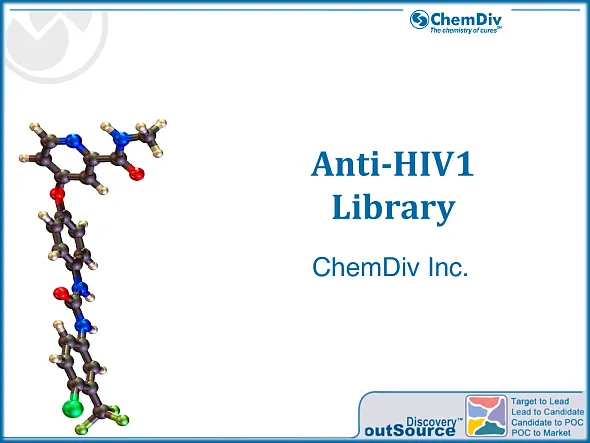Anti-HIV1 Library
ChemDiv’s library of anti-HIV1 small molecule agents contains 21,000 compounds.
One major challenge in treating human immunodeficiency virus (HIV) is its high genetic variability. HIV is categorized into two primary types: HIV type 1 (HIV-1) and HIV type 2 (HIV-2). Of these, HIV-1 is the more prevalent and pathogenic strain. Scientists have further classified HIV-1 into a major group (Group M) and several minor groups, namely Group N, O, and potentially Group P. Each of these groups is thought to represent a separate cross-species transmission of Simian Immunodeficiency Virus (SIV) to humans. Both HIV-1 and HIV-2 have developed resistance to antiretroviral drugs due to natural selection and genetic mutations that have been extensively studied and documented.
The development of new anti-HIV1 drugs is crucial in the ongoing battle against HIV/AIDS. With the virus’s ability to rapidly develop resistance to existing treatments, this library serves as an essential tool in identifying next-generation therapeutics that can provide effective, long-lasting control of HIV-1 infection. The use of small-molecule drugs presents several advantages over antibody-based treatments, including lower production costs, no need for cold-chain transportation, and the possibility of oral administration, eliminating the requirement for injectable delivery [1]
The anti-HIV1 small molecule library is a specialized collection designed for the discovery and development of novel HIV-1 therapeutics.
This library is highly curated to target key proteins essential for HIV-1 replication and survival, including protease, integrase, CXCR4, maturation proteins, reverse transcriptase, CCR5, and components crucial for nucleocapsid formation. By focusing on these specific proteins, the library offers a multifaceted approach to disrupting the HIV-1 lifecycle at various stages.
The compounds in this library are characterized by a diverse range of molecular structures, specifically chosen for their potential to interact effectively with the selected HIV-1 targets. This diversity is critical in identifying compounds that can bind to and inhibit these proteins, thereby halting the virus's replication process. Recognizing the challenge of HIV-1’s high mutation rate, the library is designed to include small molecules that not only target the virus effectively but also possess a high genetic barrier to resistance. This approach aims to prolong the efficacy of potential drugs derived from these compounds.
Emphasis is placed on novel chemistry and mechanisms of action, aiming to discover unique compounds that could offer new therapeutic options, especially for patients with drug-resistant HIV-1 strains.
This anti-HIV1 small molecule library offers researchers and pharmaceutical companies a valuable resource for the development of novel antiretroviral drugs. The library's focus on a broad spectrum of viral targets increases the likelihood of discovering compounds with unique and potent antiviral activities. Its design, geared towards overcoming drug resistance, is particularly beneficial in developing treatments that remain effective over time, addressing one of the most significant challenges in HIV therapy. Additionally, the emphasis on novel chemical structures and mechanisms provides an opportunity to expand the current repertoire of HIV treatments, offering hope for more effective management of HIV/AIDS worldwide.
References
[1] Su, S., & Jiang, S. (2020). Anti-HIV agents inspired by antibodies. Nature Chemical Biology, 16(5), 483–484. doi:10.1038/s41589-020-0521-1
